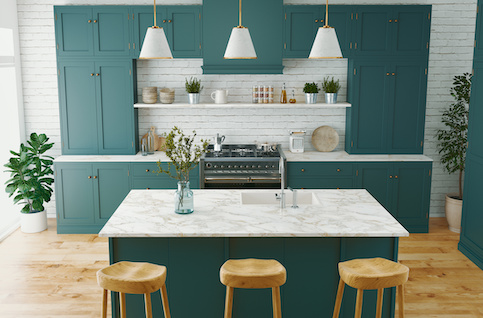Should it stay or should it go? Whether you’re moving into a new home or moving out of your old one, you might be wondering which items stay with the home and which ones can go with the previous owner to their new home.
The question of fixtures versus personal property can be a contentious topic of debate among the parties involved in a mortgage. Sometimes, it can even be a deal killer.
Typically, the purchase agreement will list which fixtures are included. However, problems can still arise, and spelling it out in the contract doesn’t always prevent sellers from getting surprise calls on final walkthrough day letting them know that they weren’t supposed to take that expensive chandelier they’d planned on installing in their new home.
To avoid issues that could potentially sour their home sale or purchase, it’s important that buyers and sellers familiarize themselves with the concept of real estate fixtures and what they are (and aren’t).
What Is A Real Estate Fixture?
Because determining if something is a fixture or personal property isn’t always obvious or intuitive, it can be a common source of conflict during home purchase transactions. Fortunately, there are a few commonly accepted guidelines that the pros use to settle disputes.
The main guiding principle regarding whether something is a fixture or not has to do with its method of attachment. If an object is physically and permanently attached or fastened to the property, it’s considered a fixture. This includes items that have been bolted, screwed, nailed, glued or cemented onto the walls, floors, ceilings or any other part of the home.
A classic example of this is a window treatment. Typically, things like blinds and shades are considered fixtures that must stay with the home because they’re physically fastened to the window frame.
On the other hand, drapes and curtains that hang on a rod are usually classified as personal property. However, the rod that those drapes are hanging on would likely be considered a fixture, since it’s attached to the wall.
Unless you’ve stipulated otherwise in the contract, if something would reasonably be a fixture, you can’t take it with you when you move. If you have fixtures in your home that you want to take with you when you move out, you may want to consider replacing those items before any prospective buyers see your property.
Are Fixtures Considered Chattel Property Or Real Property?
“Chattel” is another word for personal property, or a movable piece of property, like furniture, certain machinery or something as big as a trailer. Real property is the term often used for anything affixed to the property and the surrounding land.
This can include the house itself, sheds, ponds, basketball courts and anything that couldn’t be easily removed from the property. In short, chattels are not fixtures, but real property is, as well as anything permanently attached to it.
Find A Mortgage Today and Lock In Your Rate!
Get matched with a lender that will work for your financial situation.
See What You Qualify For
Buy A Home
Discover mortgage options that fit your unique financial needs.

Refinance
Refinance your mortgage to have more money for what matters.
Tap Into Equity
Use your home’s equity and unlock cash to achieve your goals.
How To Define And Determine If Something Is A Fixture
Whether or not an item would be considered a fixture isn’t always cut and dried, and each state or locality may have its own guidelines for what qualifies as a fixture.
The main way to determine if something is a fixture is whether it’s attached to the home. Beyond that, it can get a little fuzzy, though there are still some tests to help determine whether an object is a fixture.
The best way to head off disputes is to be very thorough and specific about what stays with the home in your purchase contract.
MARIA And Fixtures
MARIA is an acronym used by some real estate professionals as an easy way to remember the criteria for determining if an item is a fixture or not.
“M” stands for “method of attachment.” When determining if an item is a fixture, look at how it’s attached to the home. Things that are screwed, glued or otherwise permanently affixed to the property are fixtures.
“A” is for “adaptability.” This test refers to whether an item has become an intrinsic part of the property, even if it is easily removed. A common example would be floating flooring. This type of flooring isn’t nailed down to the subfloor and instead “floats” on top of it, but it’s still considered to be an integral part of the home and, thus, a fixture.
“R” is for the “relationship of the parties.” If all else fails and a judgment must be made, who’s who in a complaint can make a difference. In seller/buyer disputes over fixtures, buyers tend to have the upper hand. This is because it’s generally assumed that if a seller installs something in their home or makes some sort of alteration, their intent is for it to be a permanent addition to the property. This is contrasted with tenant/landlord fixture disputes, where it can be assumed that the tenant had the intention of taking any fixtures they installed themselves with them when they moved out.
“I” stands for “intention.” Similar to the previous criterion, this test tries to determine whether the homeowner could have reasonably intended the item to become a permanent part of the real property.
“A,” finally, is for “agreement.” This refers to what’s written in your contract. When in doubt, your purchase agreementis your best guide to what is and isn’t included in the sale.
Examples Of Fixtures In Real Estate
It helps to know what items are typically considered fixtures or not. Read some examples below.
Fixtures
The following items are commonly left in the home after it’s sold:
- Washers and dryers
- Ceiling fans
- Chandeliers
- Curtain rods
- Towel racks
- Blinds and window coverings
- Built-in shelving and cabinets
- Smoke and carbon monoxide detectors
- Landscaping (anything planted in the ground)
Non-Fixtures
These items will typically go with their owners to their new home:
- Furniture
- Refrigerators
- Rugs
- Detached bookshelves
- Curtains and drapes
- Yard decorations
Gray Areas For House Fixtures
Even with all this guidance to help us determine whether an item is, in fact, a fixture, disputes still happen – especially when it isn’t immediately clear whether an item is personal property or a fixture.
Say you planted a beautiful garden in your front yard that you’ve lovingly tended to for many years. When you move out, you plan to dig it up to transplant to your new home. Can you do that? Some may say you can, but others may argue that it’s a part of the property, not your personal property.
What if you’re a buyer who fell in love with a home for its beautiful front yard landscaping, complete with a gorgeous row of lush, colorful flower beds – but come move-in day, the yard is all torn up from digging out the landscaping and the flower beds are nowhere to be seen?
Who is right in this scenario? Often, it comes down to what was in the purchase agreement. The best way to avoid conflicts like this is to clearly communicate what each party wants and make sure the agreed-upon terms are included in the contract.
Fixtures And Final Walkthroughs
Buyers shouldn’t assume that something is going to be included with the home, especially if it’s something they are particularly interested in. If you had your eye on the built-in bookshelf since the first showing, make sure to ask about it during contract negotiations.
If the seller takes with them an item that you had planned on remaining in the home, you can save yourself a lot of headache ahead of time by having in writing what stays and what doesn’t before the final walkthrough.
When they’re first listing their home, sellers should work with their real estate agent to clarify what objects in their home qualify as fixtures. When working with prospective buyers, be clear about what’s included in the sale.
Both parties should be clear and communicative during negotiations to prevent confusion and ensure a smooth and successful purchase.
The Bottom Line: Determine Fixtures Early Or Be Disappointed
Disputes over fixtures in real estate can cause a transaction to completely fall apart, so it’s imperative that both buyer and seller determine what’s staying and what’s going before things get too far in the process.
Find A Mortgage Today and Lock In Your Rate!
Get matched with a lender that will work for your financial situation.

Miranda Crace
Miranda Crace is a Staff Writer for Rocket Companies, bringing a wealth of knowledge about mortgages, personal finance, real estate and personal loans for over 10 years. Miranda is dedicated to advancing financial literacy and empowering individuals to achieve their financial and homeownership goals. She graduated from Wayne State University, where she studied PR writing, film production and film editing. In her spare time, Miranda enjoys traveling, actively engages in the entrepreneurial community, and savors a perfectly brewed cup of coffee.












